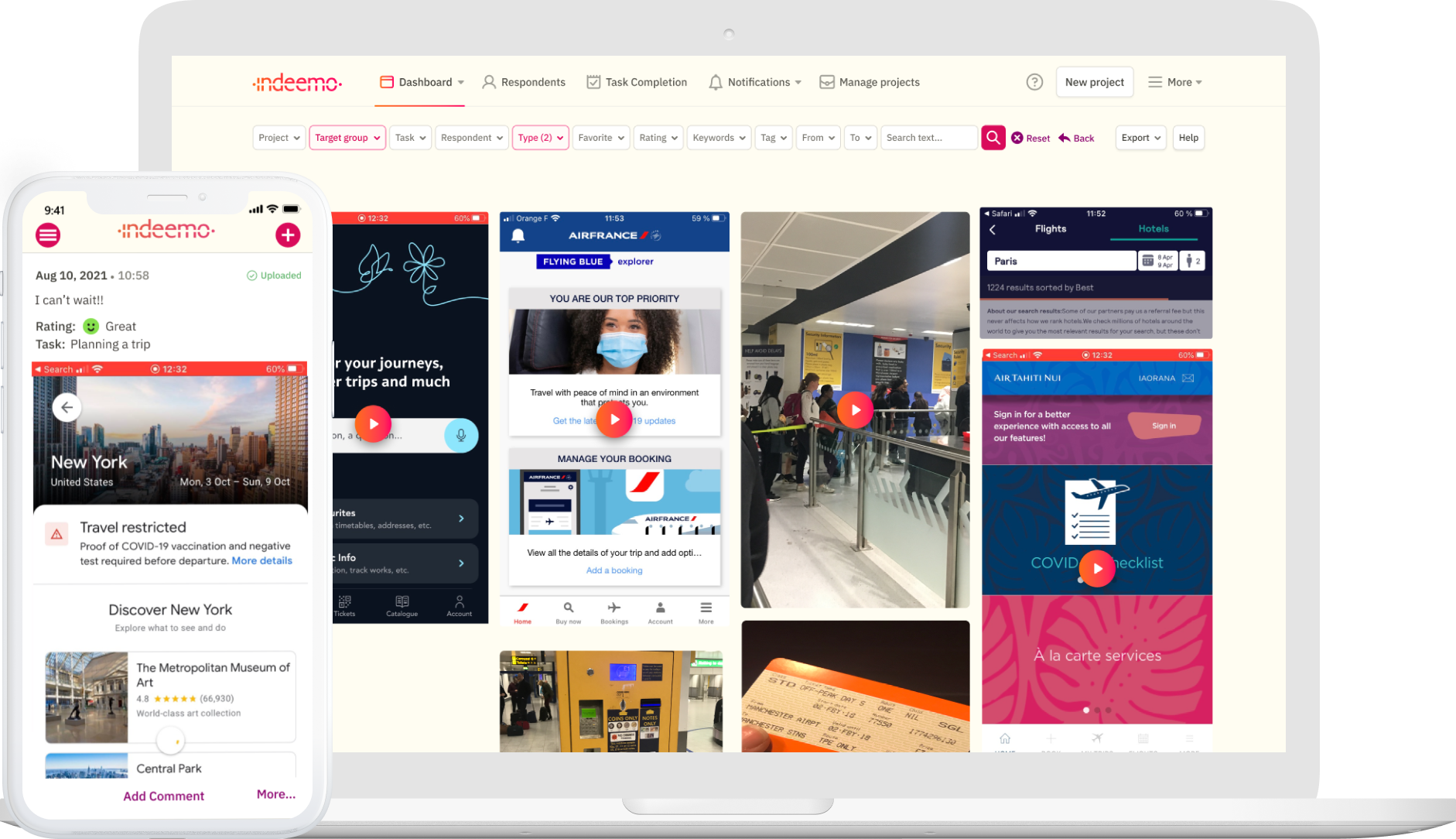Indeemo User Journey Mapping Dashboard
UX Research, or user research, are often terms used to describe the same thing. This guide outlines the concept of user experience research and gives you tips on how to conduct qualitative research to help you achieve actionable user insights.
What is User Experience Research?
For many brands, there is always the possibility that poor design or even an underwhelming user experience can prompt a potential customer to look elsewhere, leaving your product or service behind. UX research has become a way to bridge the gap between brands and customer needs. It is not a stand alone initiative. User experience research should be an ongoing process that draws on collective inputs from stakeholders, with the perspective of the end-user at the forefront product design and development.
To build the right prototype, and ultimately design the best product or service for potential customers - the motivations, behaviours, and needs of users need to be understood. UX research through various user research methods, is used to answer questions that are central to the success of a brand.
Who are your users (or customers)?
Of course, many organisations will have a wealth of information about their customers experience, product experience, and buying experience. Traditionally, market research relies on quantitative techniques to gain a broad understanding of the customer experience. UX research has an important role to play here. The needs and desires of customers shift. Innovations to consumer products and service design can, and often do, influence customer loyalty. A customer-centric organisation leverages on the insights that derive from user experience research. Qualitative methods are most commonly used through a generative research approach to help brands figure out who their customers are. More so, who their potential customers can be.
What are the Users' needs?
User Diaries, observations, and mobile usability testing are built into the UX research plan to capture the needs of users. UX teams often apply various techniques to put themselves in the shoes of the customer with an aim to understand their needs and build user empathy.
What are the pain points for Customers?
The digitisation of many brands makes it more difficult to have a singular understanding of a customer journey. Customers interact with a brand via websites, mobile apps, and even virtual reality (VR). Not every user experience is the same. Various touch points and interactions might not be seamless. Correct product design is dependent on a rich understanding of any pain points customers experience throughout their interaction with a brand. UX research uncovers these pain points.
Further reading
What is User Journey Mapping?How to do User Experience Research
There is no singular formula for conducting user research. Your UX research plan should be informed by previously uncovered insights and ongoing trends that might come from your marketing team. In this guide to user experience research, we are going to focus on the qualitative component. User research is increasingly being designed with qualitative methods. Generative research is usually designed with a distinct qualitative focus.
Share your UX Research Plan
Your UX research plan involves identifying historic and ongoing trends about your customers. Highlighting key areas that need to be addressed through your research should be part of your plan. Most importantly, bring all internal stakeholders to the table. Combine their aims for future improvements for your product or service. Silos can form quickly in an organisation. But one way to ensure you remain customer-centric is by taking onboard the goals from various internal stakeholders and sharing your ux research plan.
Outline your UX Research objective
Every user experience research project should have an overall objective. Your research objective will be formulated through problem statements your team and other stakeholders have identified. Even more, your problem statements should be informed by user insights uncovered from past ux research projects. With a qualitative approach you don't necessarily need hypotheses to test. Instead, you will want to take an exploratory approach. Also known as generative research, this approach will allow you to design an objective that will produce optimal results for user discovery.
UX Research Design
There are many types of methods and techniques that can be adopted and utilised for effective UX research. Under the generative research approach, your project can apply one or many qualitative techniques. Research design will involve identifying the best techniques for your project. Ethnography, user observations, and ux diaries are commonly applied techniques that can benefit user discovery and ux experience research.
For your research design, the duration needed for your fieldwork is important. It is not uncommon for exploratory research to be conducted longitudinally. Nonetheless, your research design will need to consider the optimal fieldwork duration for your participants to describe and report on their experiences with your product.
Fieldwork and User Activities
User activities and tasks required for your team to uncover insights will need to be incorporated into your research design. These tasks involve the activities your research participants will complete over the course of your fieldwork. A generative approach will allow you to explore the varying environmental factors and influences that impact the experiences of your potential customers.
The benefits of User Experience Research
User experience research is not new. Even more, ux research is strongly integrated into many areas of a brand. CX management, UX design, and marketing teams all leverage the insights that emerge from user experience research. The importance of user-centric research relates directly to the idea that your customers are the most important stakeholder of your brand.
User experience research can be viewed as the foundations of design innovation, and improvements to design features. Ultimately, every insight derived from ux research comes from the perspective of the user.
User experience research puts the spotlight on detailed areas of product design that might not work well for customers. Mobile user testing will always show you issues customers experience with features of design. In line with the digital experience, ux research is used to see how well can users of your product achieve their desired goal.
The qualitative element of user experience research enables user researchers to capture both user attitudes and user behaviours. Quantitative methods for user experience research typically aim to capture the attitudes and opinions users have about a design. Whilst qualitative methods are applied to capture various user behaviours - in fact, a well-designed exploratory user experience research project can be attitudinal and behavioural. It is important to note that ux research is flexible and adaptable. The use of mobile technology for ux diaries leveraging on video and photos can quickly uncover user attitudes and behaviours.
One issue all types of research face is the potential for biases to occur. User experience research will reduce this risk significantly. The importance of ux research is that it will result in unbiased feedback. Feedback and qualitative insights from the perspective of the user will help you and your team build empathy for your customers. This puts them front and centre during the design process. The ideas from other internal stakeholders will be secondary as the voice of end-users will direct the need and opportunities for your design.
The challenges of UX and User Research
Every research project will face challenges. It is important to document possible challenges that may arise. Anticipating challenges will help you with your research design. For ux research, there is always the possibility that buy-in from internal stakeholders will be difficult. A lack of buy-in can impact your budget, and ultimately reduce the flexibility you and your team will have to achieve your research objective.
Another challenge relates to recruitment. Or in this case, under recruitment. The nature of exploratory research does not require a large sample of research participants. As you are focused on the qualitative insights and the behaviours of your participants, and smaller sample will work just fine. However, it is always a good idea to over-recruit. Why? To simply put it, there is always the possibility that participants might not complete all tasks. When analysing your data, you might be underserved due to the low numbers. We recommend over recruiting slightly. This gives you the flexibility with data analysis.
Participant burden can also impact the volume and quality of data you retrieve. This comes back to your research design. Be mindful of the commitment required by your research participants. If you incorporate too many user activities and tasks over a short timeframe, this can impact engagement.
Low engagement can also be a result of the repetitiveness of tasks. It will always benefit your research outcomes by being creative with user activities. Incorporate the use of various types of media to help uncover insights and empower participants by gamifying some aspects of your fieldwork.
Data analysis can also be a challenge. For some, qualitative user research can be daunting if they are new to this approach. Analysis of contextual data involves digging into the unstructured data and yes, this can take time. However, with this type of research, you are allowed to explore. Start by segmenting and identifying various keywords. Draw out behavioural patterns, and identify emotions through various techniques like sentiment analysis. Technology plays a role with effective data analysis for user experience research. Organisations and UX teams are beginning to adopt user experience tools that will enable them to conduct rich and contextual qualitative research with a centralised repository of insights.
User Experience Research Tools
User experience research is constantly evolving. With new insights and new user needs, user researchers look to emerging techniques and methods, and innovative technology for their research projects.
User journey mapping tools are now being integrated into research design. Technology that captures the user experience in real time can be streamlined to build visual journey maps.
The use of mobile screen recordings is integral to user experience research. Mobile usability testing leverages on technologies that have built in screen recording capabilities.
A UX diary study is used to capture user attitudes. With the use of video diaries, user behaviour is quickly being recognised with emerging insights directly influencing design from the visual component.
Some technological capabilities can streamline user insights into a centralised dashboard for user researchers. It is here that in the moment data gets drawn out to form user insights.
The Indeemo User Experience Research tool is designed to bring you closer to your customers by leveraging all these capabilities. For effective user research, the technological functionalities enable researchers to gather contextual insights from the users perspective.









